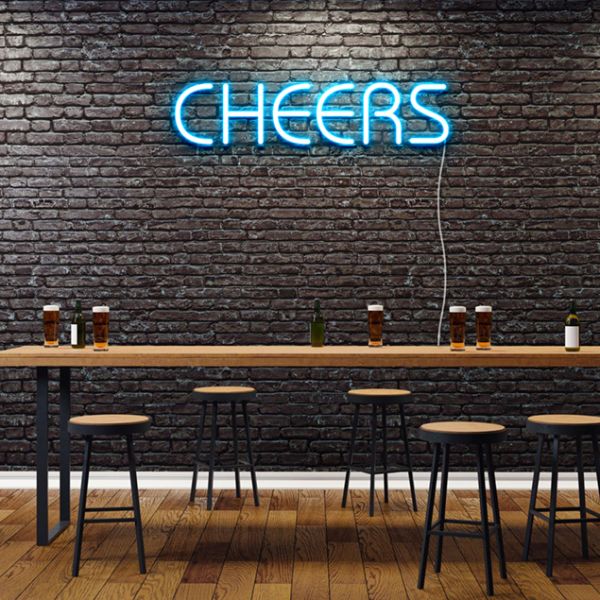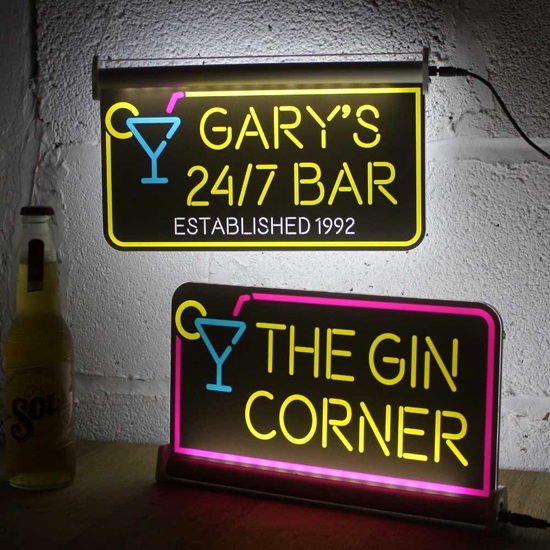Handy Info On Picking Pub Signs
Wiki Article
What's The Significance Of Bar Signs?
The reason for bar signs is a bit different. Below are some of the main functions of bar signs and their differences: 1. Branding
Logo's purpose: To strengthen and develop the brand name of bars.
Often the bar's logo, name and signature color are included. The bar's theme and overall atmosphere should be apparent in the style.
Customized metal signs bearing the bar's name or a neon sign bearing its logo are examples.
2. Information
Use: Provide vital information to patrons regarding the bar.
Features: Clear, easy-to read text that provides essential information such as hours of operation, Wi-Fi passwords, house rules, or restroom places.
The signs will indicate restrooms, or hours of operation on a wall near the entryway.
3. The Decorated
Objective: Enhance the visual appeal of bar.
Features: They are often artistic or thematic and add to the look of the bar in general. The bar may or may not contain any text.
For instance: vintage advertising for beer, funny signs or quirky artwork.
4. Promos
The purpose of this is to promote certain products such as services, events, or products.
Features: Attractive designs that draw attention to exclusive promotions, events that are coming up or new products in the menu. Use movable or temporary elements.
For example, chalkboards with daily deals, banners advertising happy hour, or posters advertising events coming up.
5. Directional
The objective of this guide is to direct customers to the bar.
Features: Well-marked arrows and instructions that help customers navigate the bar, e.g. getting to restrooms, exits or different sections.
Signs pointing out the restrooms, "Exit", arrows indicate different seating sections.
6. Regulatory/Compliance
Purpose: Comply with the legal requirements, and also to make sure that you are safe.
Features: Signs necessary for legal requirements. These include signs to indicate smoke-free zones or occupancy limits as well as emergency exits.
For example, "No Smoking", "Occupancy Limit" and "Emergency Exit" signs.
7. Interactive
Purpose: To engage customers and provide an engaging experience.
Features: The elements that encourage patron involvement. Examples are write-on surfaces as well as digital interaction.
Examples: Chalkboards for customer messages, signage with QR codes that link to digital menus, or social media.
8. Thematic
Create a certain mood or theme.
Highlights: Signs that are aligned with the theme of the bar making a difference to the overall ambience and ambience.
Examples: Pirate-themed signage in a bar with a maritime theme or rustic wooden signs for bars that are themed to the country.
9. Menu
The menu will be displayed on the bar.
Features: Lists clearly foods and drinks and food items, usually with prices. It can be fixed or changeable.
Examples Screens that are digital and display rotating menu items, wall-mounted drinks menus.
Every bar is unique and is designed in a manner to satisfy that specific need. Understanding the different types of signage will assist bar owners select and install signs to satisfy their needs and improve the experience for their customers. Have a look at the top he has a good point on bar signs for home for website advice including large bar signs, home garden bar signs, personalised cocktail bar sign, bar pub signs, garden pub signs, personalised garden bar signs, personalised pub signs, bar sign design, home garden bar signs, bar sign design and more.

How Does Bar Sign Customization And Personalization Differ?
There are a variety of options for personalization and customization of bar signs to reflect each establishment's distinctive brand, style, and feel. What are the differentiators in bar signs when it comes to individualization and customization? Material
Customizable Materials : Wood, metals, acrylic, neon LED, chalkboard, and vinyl
Personalization: Select items that are in line with the theme of the bar and its aesthetic, such as rustic wood for a warm pub or sleek acrylic for a modern lounge.
2. Design
Custom Graphics: Illustrations, typography and artwork.
Personalization: Use brand-related elements or images that represent the bar's personality and the atmosphere.
3. Shape and size
Custom Sizes: Small tablestop signs, to huge outdoor marquees.
Personalization: Customize the dimensions and shapes of signs to meet particular spaces and to accommodate branding needs, such as big letters for a bold piece, or small signs for small spaces.
4. Color
Custom color schemes: Pantone matching as well as RGB options.
Personalization: Select colors that reflect the brand character of your bar the interior design, as well as the tastes of your target audience, whether they are striking and bold, or subdued, elegant and delicate.
5. Lighting
Custom Lighting Effects Neon LED, backlit edge-lit projections or other.
Personalization: Choose lighting options that increase visibility and ambience while blending with the theme of the bar and mood, such as neon for a retro vibe or LED for a modern accent.
6. Text Messages
Custom Text: Bar name, slogans, quotes, menu items, event announcements.
Personalization: Create messaging that is unique to the bar, connects with its patrons and communicates effectively promotions, specials, and brand values.
7. Interactivity
Custom Interactive Features: QR Codes, digital displays or interactive projections.
Personalization: Create memorable experiences by using interactive elements such as digital menu boards or games that are interactive.
8. Installation and Mounting
Custom Mounting Options: Wall-mounted mounting, hanging, freestanding mounting or window mounted mounting.
Personalization: Choose mounting options that match the bar's layout, increase visibility, and integrate seamlessly with the overall design style that is minimalist and sleek or bold and attention-grabbing.
9. Seasonal and Event Specific
Custom Themes : Christmas decorations or seasonal themes.
Personalization: Ensure that you regularly update your signs to reflect seasonal changes or celebrate holidays. It is also possible to promote special occasions. This creates an exciting atmosphere that is engaging for your customers.
10. Brand Consistency
Logos, fonts and colors are all customized branding elements.
Personalization: Consistency is crucial throughout all signage and branding materials. This will reinforce the brand's identity, boost brand recognition and provide the same experience for patrons.
The Benefits of Customization & Personalization
Brand Differentiation: Make yourself stand out and make a lasting impression.
Brand Identity: Enhance the brand's image by encouraging customer loyalty.
Atmosphere Enhancement: Create a custom-designed the bar's signage to reflect the bar's atmosphere and atmosphere. This will enhance the overall experience for customers.
Personalized signs can spur conversations, encourage interaction and create excitement.
Utilizing the personalized and customizing features bar owners can design unique, effective signs that do not just convey information, but also contribute to the aesthetics, ambience branding, and overall appearance of their establishment. Read the best helpful resource for pub signs for blog tips including hanging tavern sign, bar wall signs, personalised hanging pub signs, bar wall signs, pub signs to buy, personalised home bar signs, bar sign outdoor, garden bar sign personalised, novelty bar signs, personalised signs for bar and more.

What Is The Difference Between Bar Signs From One Another In Regulations Terms?
Bar signs are subject to a myriad of rules by local, state and federal authorities in order to ensure public security, aesthetic standards and compliance with zoning law. What regulations apply to bar signs? Size and placement regulations
Zoning Laws: Regulations dictate the location of signs as well as their size, height and distance from property lines, roads or buildings adjacent to them.
Historic Districts - Signs may be restricted in terms of dimensions, style, and material to preserve the historical characteristics of certain areas.
2. Illumination Restrictions
Light Pollution: To minimize light pollution and to preserve nighttime settings, laws may restrict the brightness of the signs, their colors and their duration.
Safety: Signs near roadways and other areas should be designed so as to prevent an obstructive or distracting effect that could be dangerous to pedestrians or motorists.
3. Content from the Signage
Alcohol Advertising Certain jurisdictions have limitations on alcohol-related advertising. These include the prohibition of certain images or content that entices minors, and encourages drinking to excess.
Health Warnings. Laws may require signage that warns of the dangers of smoking cigarettes or alcohol consumption.
4. Historic Preservation Regulations
Signs in historical districts have to be compatible to the architectural style or design of the area. This requires the approval of preservation boards.
Signs can be restricted in terms of their materials, designs, and colors in order to protect the integrity of history.
5. Sign Permitting Process
Permit requirements: Before putting up or changing the signs the bar owners have to obtain permits. This may require submitting plans, paying fees and obtaining approval from the local authorities.
Code Compliance: Signs must to conform with the codes for building and fire safety regulations as also accessibility standards to protect the public and ensure accessibility for people with disabilities.
6. Repair and removal of signs
Maintenance Requirements. Bar owners are held to an obligation to maintain their the signs in good condition by ensuring they're free of hazards and comply with all guidelines.
Abandoned sign: To prevent blight from the area and to preserve its beauty, rules could be in place to govern the removal.
7. Digital Signage Regulations
Content Restrictions. There could be laws that restrict the types of content shown by digital signs. They could also restrict flashing lights or images that offend.
Operational Limits Regulations may limit the brightness of digital signs, motion and frequency to minimize visual clutter.
8. Penalties and Enforcement
Inspections are conducted by local authorities in order to check the compliance of signage laws. Violations will be cited.
Penalties: If you fail to comply, penalties may include citations or fines. These could also be the removal of signs or alter them, or even legal actions.
9. Sign Variance Process
Bar owners can apply for Variances: Bar owners may request variances to deviate the sign regulations that are standard. They must prove they have a valid justification for their decision and limit any negative effects on aesthetics or safety.
Public Participation. Variances could require public hearings and/or input from members of the community. This may include property owners nearby or business associations as well as members of neighboring communities.
10. Community Engagement and Input
Public Consultation - Some areas include community members in the development and application of signage regulations, by conducting public consultations or surveys.
Community Benefits: Sign Regulation may include provisions that enhance the quality of signage or advertise local businesses. They can aid in revitalizing neighborhoods.
By adhering to the signs regulations, bar owners are able to ensure that the signage they put up enhance the visual appeal and value of their establishment, as well as contribute to the local community. They'll also be legally compliant and reduce the chance for fines, penalties or legal battles. Check out the top bar sign advice for site info including signs for garden bar, personalised metal bar signs, home pub signs, pub wall sign, personalised pub signs, personalised outdoor pub signs, large bar signs, personalised pub, personalised signs for home bar, personalised bar signs and more.
